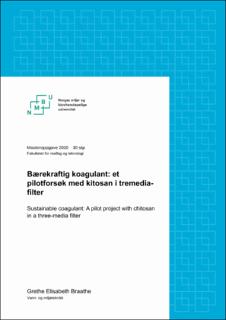| dc.contributor.advisor | Hem, Lars | |
| dc.contributor.author | Braathe, Grethe Elisabeth | |
| dc.coverage.spatial | Norway, Akershus | en_US |
| dc.date.accessioned | 2020-09-23T13:40:25Z | |
| dc.date.available | 2020-09-23T13:40:25Z | |
| dc.date.issued | 2020 | |
| dc.identifier.uri | https://hdl.handle.net/11250/2679336 | |
| dc.description.abstract | Denne masteroppgaven er initiert av Asker og Bærum vannverk og vann- og avløpsetaten i Oslo kommune. De samarbeider om et pilotanlegg ved Kattås renseanlegg i Bærum for å teste om ulike rensemetoder håndterer fargeøkning i Holsfjorden. Pilotanlegget er bygd opp som et Moldeanlegg som renser vekk farge og partikler via koagulering og kontaktfiltrering. Moldeanlegget består av et tremedia-filter bygget opp av filtralite NC (0,8 – 1.6 mm), filtersand (0,4 – 0,8 mm) og filterkalk (1 – 3 mm).
Hovedmålet med oppgaven var å undersøke hvorvidt kitosan kan erstatte PIX-318 A15 (surt jernkloridsulfat) som koagulant i pilotanlegget med råvann fra Holsfjorden. Det ble undersøkt flere koagulantdoser (1,5 – 5,0 mg/l) og koagulerings-pH (4,0 – 5,6) for å se effekten av de ulike koagulantdosene på modningstid (med to ulike grenseverdier), driftstid og fargefjerning i filteret. Forsøkene er gjennomført med konstant lav filterbelastning på 3,5 m/t.
Resultatene viser kortest modningstid ved kitosandose 2,5 mg/l og lengst modning ved dose 5,0 mg/l. Driftstiden er lengst ved dose 2,5 mg/l og ingen driftstid ved dose 5,0 mg/l med turbiditetsgrense 0,1 FNU. Fargetallet er lavest ved dose 3,0 mg/l ved pH 5,6 og høyest fargetall er ved høy dose (5,0 mg/l) og lav dosering (1,5 – 2,0 mg/l). Modningstiden er innenfor anbefalt lengde, men fargetallet ved bruk av kitosan er ikke under Mattilsynets anbefalte grenseverdi for koaguleringsanlegg. Ved å sammenligne driftsresultatene fra forsøkene med PIX-318 og kitosan, viser resultatene bedre renseeffekt og lengre driftstid ved bruk av PIX-318 som koagulant.
På bakgrunn av de nevnte resultatene vil det være interessant å undersøke hygienisk barrierevirkning ved bruk av kitosan, for å undersøke om reduksjon i turbiditet korrelerer med reduksjon i bakterier, virus og parasitter. Videre indikerer resultatene fra dose 4,0 mg/l med pH-spekter 4,0 – 5,5 store forskjeller i fargereduksjon og modningstid med fast dose og ulik pH. Ytterligere studier av pH-påvirkning ved ulike doser kitosan kan gi ny kunnskap om dette. | en_US |
| dc.description.abstract | This thesis was initiated by the municipalities of Asker, Bærum and Oslo. The three municipalities are collaborating on a pilot project at Kattås drinking water treatment plant, in Bærum. The intention is to test the ability of different treatment methods to handle colour increases in Holsfjorden. The pilot project is designed based on the Molde-processing plant to remove colour and particles through coagulation and contact filtration. The Molde-processing plant is a three-media filter made up by Filtralite NC (0.8 – 1.6 mm), filter sand (0.4 – 0.8 mm) and limestone (1- 3 mm).
The main purpose of this thesis was to investigate whether chitosan can replace PIX-318 A15 (iron chloride sulphate) as a coagulant in the pilot project, with raw water from Holsfjorden. Different doses of chitosan (1.5 – 5.0 mg/l) with different pH-levels (4.0 – 5.6) were studied to see the effects upon ripening time (with two limit values), operating time and colour removal in the filter. The hydraulic load was constant at 3.5 m/h during the study.
The study shows the shortest ripening time with a chitosan dose of 2.5 mg/l and longest ripening at 5.0 mg/l. The operating time is the longest with a dose of 2.5 mg/l and non-existent operating time with a dose of 5.0 mg/l, and at turbidity limit 0.1 FNU. The colour level is lowest at a dose of 3.0 mg/l and at pH 5.6. The highest with high (5.0 mg/l) and low dosage (1.5 – 2.0 mg/l) at pH 5.4. The ripening times are within the recommended length, but the colour levels are over Norwegian Food Safety Authority’s recommended limit value for coagulation plants. By comparing the operating results from the experiments with PIX-318 and chitosan, the results show better water quality and longer operating time with PIX-318 as the coagulant.
Based on the above results, it might be interesting to investigate the hygienic barrier effect of chitosan, to see whether there is a correlation between reduced turbidity and bacteria, viruses and parasites. Furthermore, the results with chitosan dose 4.0 mg/l at pH-level 4.0 - 5.5 indicate large differences in colour reduction and ripening time with fixed dosage and different pH values. Further studies on pH effects at various doses of chitosan may provide new knowledge concerning this. | en_US |
| dc.language.iso | nob | en_US |
| dc.publisher | Norwegian University of Life Sciences, Ås | en_US |
| dc.rights | Attribution-NonCommercial-NoDerivatives 4.0 Internasjonal | * |
| dc.rights.uri | http://creativecommons.org/licenses/by-nc-nd/4.0/deed.no | * |
| dc.subject | Moldeanlegg | en_US |
| dc.subject | Kontaktfiltrering | en_US |
| dc.subject | Contact filtration | en_US |
| dc.title | Bærekraftig koagulant : et pilotforsøk med kitosan i tremedia-filter | en_US |
| dc.title.alternative | Sustainable coagulant : a pilot project with chitosan in a three-media filter | en_US |
| dc.type | Master thesis | en_US |
| dc.description.localcode | M-VM | en_US |

